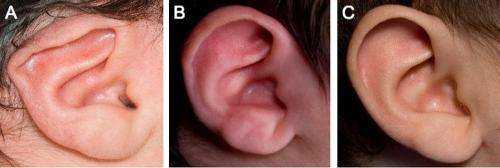Identification of newborn congenital ear deformities allows for timely, non-surgical correction

(Medical Xpress)—Enlisting newborn hearing screeners to help identify common ear deformities allows doctors to easily correct the condition without surgery before a baby leaves the hospital, according to a new study by researchers at the Perelman School of Medicine at the University of Pennsylvania. The new study is published online ahead of print in the International Journal of Pediatric Otorhinolaryngology.
"We've known for some time that by simply splinting the ears of newborns with congenital auricular deformities, we're able to effectively reshape the impaired cartilage to prevent the need for future surgery," said the study's senior author, Oren Friedman, MD, director of Facial Plastic Surgery at the Hospital of the University of Pennsylvania and associate professor of Otorhinolaryngology: Head and Neck at Penn. "But we need to get to these newborns within the first three days after birth. It made perfect sense to enlist the help of hearing screeners in this endeavor, as they typically perform an in-hospital exam on babies within 24 to 48 hours. It is an ideal opportunity to identify these deformities and allow doctors to take action quickly."
Congenital auricular deformities are birth defects affecting the shape and position of the ear. The soft cartilage around the ear and other structures that affect both the function and appearance of the ear may be involved. The incidence of these deformities varies based on the type and between racial and ethnic groups, however studies have found that up to 30 percent of children have some type of ear deformity at birth. If left untreated, some of these deformities can cause significant functional and social impairment, requiring major surgical intervention at a future date.
In the new study, newborn hearing screeners received education on evaluation of congenital auricular deformities by a team of otolaryngologists and were provided an easy to use sheet to keep with them at all times of photos and illustrations of the most common ear deformities. When the newborn hearing screeners identified infants with congenital auricular deformities during a standard hearing exam, the infant's primary care medical team was alerted. The primary care team then notified the family that an otolaryngologist would evaluate the infant's ears.
During the study timeframe, ten infants with 19 affected ears amenable to treatment were treated with a simple splint. All ears were assessed by physical examination and photographic documentation prior to splinting and at follow-up visits. Splinting was initiated prior to the infant's discharge from the hospital. All of the patients exhibited improvement from the original deformity after one to four weeks of splinting and there were no instances of skin irritation or breakdown.
"In addition to the results from this study, this technique has been used with great success for many newborns at Pennsylvania Hospital in the last year," said Friedman. "We have employed excellent screening methods utilizing a multi-disciplinary team of experts at the busiest birthing hospital in Philadelphia to ensure our patients get the best possible care."
Friedman and his co-authors note that over time, this approach may prove to be a cost-effective, minimalist method to manage the vast majority of congenital auricular deformities. It may also prove to enhance the psychosocial functioning of children during the formative years, which can improve their life-long well-being.














